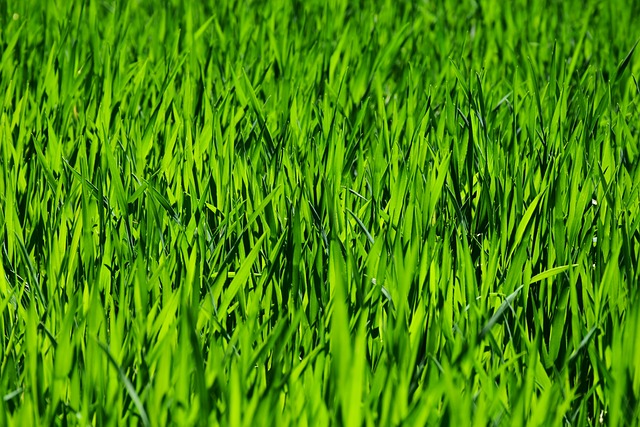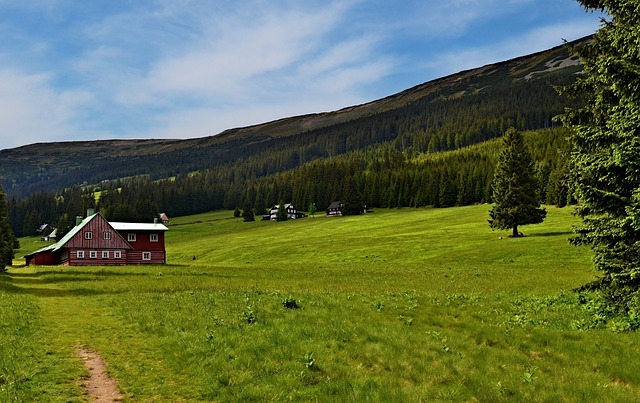Effective lawn care and landscaping are pivotal for creating a visually striking and environmentally friendly outdoor space. A healthy, green lawn requires species-specific maintenance, including the right mowing height, appropriate watering schedules to prevent over-saturation or drought stress, and regular aeration and fertilization tailored to address soil compaction and nutrient needs. Managing thatch is also crucial to prevent disease and pest issues. For a sustainable approach, organic fertilizers are recommended over synthetic chemicals to protect water sources. Water conservation techniques and efficient irrigation systems are essential for lawn care. Incorporating native plants into the landscaping design not only supports local biodiversity but also requires less maintenance. Strategic placement of vegetation can offer natural shade and windbreaks, reducing the need for extensive turfgrass care. Additionally, features like rain gardens and xeriscaping are eco-friendly solutions that contribute to stormwater management while enhancing the overall aesthetic. By combining meticulous lawn maintenance with thoughtful landscaping choices, you can achieve a harmonious outdoor environment that is both beautiful and sustainable. This synergy between lawn care and landscaping not only elevates the appearance of your property but also creates an inviting and peaceful retreat that can be enjoyed for years to come.
Embark on a journey through the lush greens of your yard with our comprehensive guide on landscaping design and implementation. This article delves into the art of nurturing your lawn through the fundamentals of lawn care, setting a healthy foundation for any outdoor space. Learn how to weave sustainable practices into your lawn maintenance routine, ensuring both environmental responsibility and vibrant vegetation. As you progress, discover innovative landscaping designs and techniques that elevate your outdoor environment into a harmonious blend of form and function. Whether you’re a seasoned gardener or a novice looking to enhance your property, this guide offers valuable insights on lawn care and landscaping to transform your yard into a tranquil retreat.
- Understanding the Fundamentals of Lawn Care for a Healthy Foundation
- Integrating Sustainable Practices into Your Lawn Care Routine
- Enhancing Your Outdoor Space with Creative Landscaping Designs and Techniques
Understanding the Fundamentals of Lawn Care for a Healthy Foundation

A well-maintained lawn is the cornerstone of any effective landscaping design, providing a lush and inviting foundation that enhances the aesthetic appeal of a property. To achieve this, understanding the fundamentals of lawn care is paramount. Lawn Care involves a series of practices tailored to the specific type of grass and local climate. Regular mowing at the correct height for the grass species prevents stress and promotes healthy growth, while consistent watering ensures the soil remains moist but not saturated. Aeration and fertilization are also crucial components of lawn care; they allow nutrients to reach the roots more effectively and alleviate soil compaction, which can impede root development and water uptake. Additionally, managing thatch build-up by regularly raking or dethatching the lawn can prevent disease and pest infestations, as excess thatch can hold moisture against grass blades, creating an environment conducive to these issues. Implementing a comprehensive lawn care regimen requires attention to detail and a commitment to regular maintenance activities, which collectively contribute to a healthy and resilient lawn. Landscaping professionals often emphasize the importance of soil testing to determine the right pH balance and nutrient levels, as well as integrating landscaping elements that complement the lawn, such as strategic plantings, mulching, and proper irrigation systems, to create an overall harmonious outdoor space.
Integrating Sustainable Practices into Your Lawn Care Routine

Maintaining a lush, vibrant lawn is a pursuit that marries aesthetics with ecological responsibility. Integrating sustainable practices into your lawn care routine not only ensures the health of your grass but also contributes to environmental conservation. One key aspect of eco-friendly lawn care is the selective application of organic fertilizers, which nourish the soil and plants without the use of synthetic chemicals that can leach into groundwater and harm local ecosystems. Water conservation is another vital component; employing drip irrigation systems or watering during the coolest part of the day helps to minimize waste and protect precious resources. Additionally, practicing proper mowing techniques by keeping the blades sharp and set to a higher cut can reduce the need for fertilizers and promote a healthier lawn that is resistant to weeds and pests.
Landscaping design plays a crucial role in supporting sustainable lawn care practices. Designing with native plants, for example, creates a harmonious landscape that requires less maintenance and is better adapted to local climate conditions. The strategic placement of trees, shrubs, and flowers can provide natural shade and windbreaks, reducing the amount of sunlight and water your turfgrass needs. Furthermore, incorporating elements like rain gardens or xeriscaping into your lawn care routine not only enhances the beauty of your property but also supports biodiversity and helps manage stormwater runoff, further contributing to the health of the local environment. By thoughtfully integrating these sustainable practices into your lawn care and landscaping efforts, you can create a landscape that is both visually appealing and ecologically sound.
Enhancing Your Outdoor Space with Creative Landscaping Designs and Techniques

Embellishing your outdoor space through imaginative landscaping designs and techniques can significantly elevate the aesthetic appeal and functionality of your property. Lawn Care and Landscaping play pivotal roles in this transformation, as a well-maintained lawn serves as the canvas for your garden’s artistic expression. Integrating diverse elements such as stone pathways, water features, or unique plant selections can create a visually captivating environment that invites exploration and relaxation. By thoughtfully combining natural textures and vibrant colors with innovative hardscaping elements, you can design an outdoor space that is both harmonious with its surroundings and distinct in character. The key to success lies in the balance between form and function; ensuring your lawn remains lush and healthy while incorporating features that complement the natural contours of the land. Engaging in regular lawn maintenance, strategic planting, and thoughtful landscaping choices will result in an outdoor haven that offers beauty and tranquility for years to come.
In conclusion, a well-designed landscape not only elevates the aesthetic appeal of your outdoor space but also fosters a sustainable environment. By understanding the fundamentals of lawn care and integrating sustainable practices into your routine, you lay a healthy foundation for a vibrant lawn that serves as the canvas for creative landscaping designs. The key to achieving both a thriving landscape and environmental harmony lies in the conscientious application of these principles. Homeowners and professionals alike can enhance their outdoor areas with innovative design techniques, ensuring their gardens are not just beautiful, but also beneficial for local ecosystems. Embracing lawn care and landscaping as integral aspects of your property’s upkeep will reward you with a serene, functional, and sustainable sanctuary.